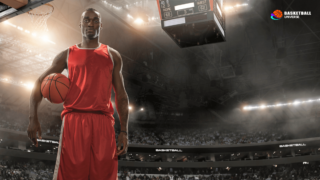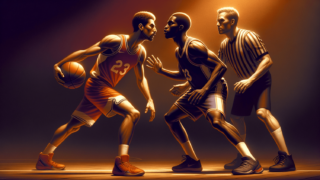
What Is the Baseline in Basketball?
Written by: Basketball Universe
Last updated:

The exhilarating world of basketball can be as enthralling to watch as it is intricate to understand. Unraveling these complexities, one bounce at a time, we find ourselves at the foundation that helps make this beloved sport a marvelous symphony of athleticism and strategy. Enter the baseline – an essential element that remains omnipresent throughout the game, yet is often overlooked by many. In this engaging blog post, we’re diving headfirst into the nitty-gritty of the all-important baseline. So, sit back, lace up your sneakers, and prepare for an in-depth exploration into this unassuming, yet paramount feature of the game, as we enhance your grasp on everything there is to know about the baseline in basketball.
What Is the Baseline in Basketball?
The baseline in basketball refers to the boundary line running along the width of the court at both ends, behind the backboards. It marks the limit of the playing area, and any player crossing or touching the baseline while holding the ball is considered out of bounds. The baseline also serves as the starting point for various inbounding plays and is a strategic area for players to exploit during the game.
Function and Importance of the Baseline
The baseline in basketball is both a boundary and an opportunity. Any player with possession of the ball who goes beyond the baseline is considered out of bounds, which in turn gives the ball to the opposing team. Additionally, the baseline serves as the launching pad for many inbounding plays as well as strategic moves that influence the game’s outcome. It’s essential to maximize the baseline’s potential to elevate both individual and team performance. Let’s delve further into the functionalities and significance of the baseline in the game of basketball.
Out of Bounds: Understanding the Rule
Whenever the basketball comes into contact with the baseline, it’s considered out of bounds, and the team responsible for the action loses possession. This rule can be applied under various circumstances, such as a player stepping on the line while holding the ball, the ball bouncing on the line, or a pass inadvertently landing on the baseline. Therefore, possessing a good spatial awareness of the court and understanding one’s teammates’ movements are crucial for avoiding mistakes related to out-of-bounds plays.
Inbounding the Basketball: Executing Plays
Inbounding plays are inevitable occurrences throughout a game, considering that they happen every time a team scores or the ball goes out of bounds. The inbounding player is granted a 5-second window to throw the ball back into the court, initiating a play or resuming the game. Many teams develop intricate plans, utilizing player screens and cutting movements, to maximize the opportunities that the baseline provides. For players, mastering inbound plays can lead to more successful scoring opportunities and a better chance of winning.
Offensive and Defensive Strategies around the Baseline
From an offensive standpoint, the baseline provides unique opportunities for teams to create space and exploit defensive weaknesses around the basket. Meanwhile, defenders face the challenge of containing offense-driven players, keeping an eye on the court, and not crossing the out-of-bounds line accidentally. In this section, we will explore several offensive and defensive strategies revolving around the baseline that teams execute to dominate their opponents.
Offensive Strategies
1. Baseline Drives
The baseline drive is a potent offensive move wherein a player dribbles the ball along the baseline towards the basket. With speed, skill, and agility, penetrative players can exploit gaps in defense, aiming to score or create openings for teammates. Effective baseline drives often catch opponents off-guard, leading to higher-percentage shots near the rim or even drawing a foul from the defense.
2. Baseline Cuts
Off-the-ball players often use baseline cuts to find openings and outmaneuver defenders. Baseline cuts refer to running behind the defenders along the baseline to receive a pass, aiming to get an open shot or advantageous position inside the paint. Timing and coordination are key for successful baseline cuts, making them an overwhelmingly effective tool in a well-executed offense.
3. Corner Three-Point Shots
Stationed in the corner of the court, just behind the three-point line, sharpshooting players attempt what is called “corner three-point shots.” Since corner three-point shots are closer to the basket than those executed from the top of the key or the wings, they offer higher accuracy and consequently increase scoring efficiency. Therefore, many modern basketball offenses aim to create open shots in the corner, facilitating points production via a higher-percentage shot.
Defensive Strategies
1. Baseline Traps
Defensive traps are designed to put immense pressure on ball handlers, forcing turnovers or bad decisions. In a baseline trap, two defenders double-team a player near the baseline, cutting off the player’s usual passing lanes and covering the subsequent dribble options. The rest of the defenders are responsible for anticipating passes and intercepting the passing lanes. When properly executed, a baseline trap can suffocate the offense, making it difficult to proceed with their intended plays.
2. Baseline Denial
When faced with an opponent who frequently exploits the baseline offensively, defensive players can combat this by denying access to that area of the court. They can either “front” the player they’re defending and prevent them from catching the ball, or use their body positioning to warn opponents against the offensive drive. By denying baseline access, defenders make it challenging for the offense to execute their strategies and limit their scoring opportunities.
3. Boxing Out on the Baseline
A fundamental aspect of a successful defense is rebounding. Proper boxing out technique near the baseline allows defenders to limit second-chance opportunities for the opposing team. The boxing-out process involves positioning oneself between the basket and the rival player, impeding their progress and securing the ball once it’s off the rim or backboard.
Make or Break: Infamous Baseline Moments
The baseline, often an inconspicuous part of the basketball court, has occasionally served as the backdrop for iconic moments, both triumphant and heartbreaking. In some instances, players and teams have experienced game-changing scenarios that have occurred along the baseline, further emphasizing its significance. Let’s take a trip down memory lane as we revisit some of the most memorable baseline moments in the history of the sport.
Dennis Rodman’s Rebounding Prowess
Often regarded as one of the greatest rebounders in basketball history, Dennis Rodman displayed exceptional skill and tenacity when securing the basketball. It was not uncommon for Rodman to be found along the baseline, positioning himself tactically to grab loose balls and providing extra possessions for his team. Throughout the 90s, Rodman’s relentless rebounding efforts helped define the Chicago Bulls’ dynasty-related successes.
Michael Jordan’s Iconic Baseline Move
Michael Jordan’s illustrious career features multiple baseline-related highlights, but none stand out quite like his iconic baseline move against the New York Knicks in 1991. Driving along the baseline, Jordan switched the ball from his right to his left hand mid-air while gracefully evading the shot blockers, ultimately finishing the play with an acrobatic layup. This play has since become a symbol of Jordan’s mastery over the realm of basketball.
Reggie Miller’s Clutch Scoring from the Corners
Reggie Miller, one of the most feared shooters in basketball history, often found himself in the corners, behind the three-point line, threading the needle through defenses. His ability to knock down clutch baseline shots played an impactful role throughout his career, none more famous than his scoring spree against the New York Knicks in the 1995 NBA Playoffs, scoring eight points in just nine seconds.
Conclusion
While it might seem like a simple demarcation on the court, the baseline in basketball plays a quintessential role in game strategy, player positioning, and memorable moments. Understanding the baseline’s functionality and its significance in both offense and defense is essential for players looking to improve their game. As a fan, appreciating the diverse tactics and techniques utilized around this pivotal boundary line just adds another layer of excitement to the enthralling world of basketball.
Refining Your Skills Near the Baseline
Developing your skills and understanding of the baseline area in basketball can be a significant boost to your overall game. Awareness of situational tactics and mastering techniques for successful plays can be the decisive factors during competitive matches. In this section, we’ll delve into the essential elements you need to focus on when honing your basketball prowess near the baseline.
Fundamental Skills to Master
When it comes to unlocking your full potential near the baseline, a few fundamental skills deserve particular attention. By developing proficiency in these areas, you will increase your effectiveness on the court and contribute to your team’s overall success. Key skills to focus on include:
- Footwork: Your ability to maintain balance and body control is crucial when playing near the baseline. Good footwork helps players avoid stepping out of bounds and execute more efficient offensive and defensive moves.
- Jump Shot and Layup: Enhancing your jump shooting abilities can significantly increase your scoring efficiency, especially when executing shots from the corners. Similarly, mastering different layup techniques can boost your offensive prowess when performing baseline drives.
- Ball Handling: Effective ball handling is critical when playing near the baseline, as it affects your ability to exploit gaps in the defense, create space, and avoid turnovers.
- Body Positioning: Learning proper body positioning can greatly improve your chances of securing rebounds or blocking shots near the baseline. Box-out techniques and vertical jump training are crucial to defensive efforts near the baseline.
- Court Vision: Good court vision enables players to anticipate moves, spot open teammates, and make better decisions when executing offensive and defensive strategies near the baseline.
Drills for Improvement
Consistent practice is vital for refining your basketball skills near the baseline. Here are some recommended drills that focus on enhancing the essential elements discussed above:
1. Sideline/Baseline Dribbling Drill
This drill improves your ball-handling skills by focusing on your ability to control the ball along the sideline and the baseline. Players dribble the ball along the two lines, making sure to maintain control while avoiding going out of bounds. Incorporating crossover and change of speed techniques will further refine your dribbling skills close to the lines.
2. Corner Jump Shot Drill
For this drill, players stand at the corner of the court and practice taking jump shots from behind the three-point line. This exercise helps players become proficient in making corner shots along the baseline. Alternate between catching and shooting, as well as shooting off the dribble to simulate various game situations.
3. Baseline Drive and Finish Drill
Aiming to improve your skills in driving along the baseline and finishing at the rim, this drill can be executed using various finishing techniques. Dribble the ball from the wing position, drive along the baseline, and execute either a lay-up or reverse lay-up. Incorporate varying speeds and angles to simulate different game scenarios effectively.
4. Rebounding and Boxing-Out Drill
Working on rebounding and boxing-out skills near the baseline can notably benefit your overall defensive capabilities. This drill can be practiced in a group setting or with a coach or partner. Take turns shooting and rebounding, focusing on proper body positioning and boxing-out techniques. Be mindful of keeping your body low, arms wide, and eyes on the ball throughout the drill.
Baseline Trivia: The Short Corner
The short corner in basketball refers to a specific area of the court near the baseline that offers tactical advantages to both the offense and defense. This area, just behind the edge of the painted lane and close to the baseline, is considered a “soft spot” in many defensive schemes, particularly zone defenses. Offensively, players positioned in the short corner can exploit passing lanes, driving opportunities, and open shots. Defensively, the short corner can be used to bait opponents into settling for undesirable shots or disrupting their baseline-focused plays.
Understanding the intricacies of the baseline in basketball can set the stage for a more profound appreciation of the sport, while also providing invaluable knowledge to elevate your game. From mastering fundamental skills and practicing targeted drills to familiarizing yourself with court sections such as the short corner, the nuanced world of the baseline offers a rich tapestry of learning and growth for basketball aficionados.
Frequently Asked Questions
In this FAQ section, we’ve compiled a list of 13 commonly asked questions related to the baseline in basketball. Whether you’re an avid basketball fan or a curious learner, these answers provide concise explanations to deepen your understanding of this vital aspect of the game. Read on for a greater insight into the fascinating realm of the basketball baseline.
1. What are the dimensions of a basketball court, including the baseline?
A professional basketball court, such as in the NBA, measures 94 feet in length and 50 feet in width. The baseline runs along the 50-foot width of the court on both ends.
2. Can a player touch the baseline without being penalized?
A player can touch the baseline without penalty, as long as they do not have possession of the ball. If a player with the ball touches the baseline, it would result in an out-of-bounds violation, and the opposing team would gain possession.
3. Can a player jump from out of bounds and touch the ball before landing inbounds?
No, a player cannot jump from out of bounds, touch the ball, and land inbounds without facing a penalty. This action would be considered an out-of-bounds violation, and the opposing team would gain possession of the ball.
4. How many feet is the three-point line from the corner, just behind the baseline?
In the NBA, the three-point line’s distance from the corner is 22 feet, significantly closer to the basket than the 23 feet and 9 inches distance at the top of the key or along the wings.
5. Why do offensive players often drive along the baseline?
Driving along the baseline often catches the defense off-guard and exposes gaps in their coverage. It also creates scoring opportunities for the ball handler or open teammates, resulting in higher-percentage shots near the basket or chances to draw fouls.
6. How can a defensive player contest a baseline drive more effectively?
Defensive players can contest baseline drives by maintaining proper footwork, being aware of their body positioning, and denying access to the baseline. Anticipating the offensive player’s movements, staying low in a defensive stance, and seeking help from teammates can also limit the effectiveness of a baseline drive.
7. What is an inbound play and when does it occur in basketball?
An inbound play occurs when a player from one team passes the ball back into the court from behind the baseline. This happens after a scored basket, a stoppage of play due to a violation or foul, or when the ball goes out of bounds. Inbound plays are crucial to restarting the game and creating offensive opportunities.
8. What is the shot clock reset for an inbound play from the baseline?
If a team retains possession of the ball through a missed shot and subsequent out-of-bounds scenario, their shot clock will reset to 14 seconds for an inbound play. For a new possession, the shot clock resets to the full 24 seconds (in the NBA) or 30 seconds (in college basketball).
9. Can a player inbound the ball directly into the basket from the baseline?
No, a player cannot legally score by inbounding the ball directly into the basket from the baseline. The only way this would count as a legal score is if an opposing player touched the ball before it entered the basket, making it a live ball.
10. What happens if a player inbounding from the baseline steps on the court?
If a player steps on the court while inbounding the ball from the baseline, it is considered an out-of-bounds violation. The opposing team gains possession of the ball as a result.
11. What is the time limit for inbounding the ball from the baseline?
The player inbounding the ball from the baseline has a 5-second time limit to pass the ball back into play. If the player fails to do so, the opposing team gains possession due to a 5-second violation.
12. How can teams improve their inbounding success along the baseline?
Teams can improve their inbounding success by setting screens to create space for receivers, practicing various inbound plays that provide passing options, and maintaining good communication between the players. Ensuring players understand their roles and maintain awareness of the game situation also contributes to successful inbounding plays.
13. What is “short corner” in basketball and where is it located?
The
Featured Posts
- No pillar pages found.




